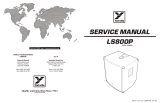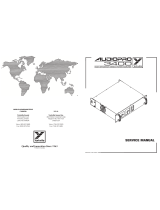Page is loading ...

Gristleizer
Filthy, dirty modulation fun
Contents of this document are ©2022 Pedal Parts Ltd.
No reproduction permitted without the express written
permission of Pedal Parts Ltd. All rights reserved.

Important notes
If you’re using any of our footswitch daughterboards,
DOWNLOAD THE DAUGHTERBOARD DOCUMENT
•Download and read the appropriate build document for the daughterboard
as well as this one BEFORE you start.
•DO NOT solder the supplied Current Limiting Resistor (CLR) to the main
circuit board even if there is a place for it. This should be soldered to the
footswitch daughterboard.
POWER SUPPLY
Unless otherwise stated in this document this circuit is designed to be
powered with 9V DC.
COMPONENT SPECS
Unless otherwise stated in this document:
•Resistors should be 0.25W. You can use those with higher ratings but
check the physical size of them.
•Electrolytics caps should be at least 25V for 9V circuits, 35V for 18V
circuits. Again, check physical size if using higher ratings.
LAYOUT CONVENTIONS
Unless otherwise stated in this document, the following are used:
•Electrolytic capacitors:
Long leg (anode) to square pad.
•Diodes/LEDs:
Striped leg (cathode) to square pad. Short leg to square pad for LEDs.
•ICs:
Square pad indicates pin 1.

Schematic + BOM
R1 47K
R2 100K
R3 10K
R4 10K
R5 1M
R6 47K
R7 47K
R8 100K
R9 47K
R10 470K
R11 470R
R12 56K
R15 10K
R16 18K
R17 47K
R18 180K
R19 10K
R20 18K
R21 6K8
R22 4K7
R23 27K
R24 47K
R25 47K
R26 180K
R27 47K
R28 47K
C1 100n
C2 6n8
C3 6n8
C4 10n
C5 100n
C6 470n
C7 2n2
C8 100u elec
C9 100u elec
C10 10u elec
C11 10u elec
Q1 2N3819*
Q2 2N3906
Q3 2N3904
IC1 7660SEPA**
IC2 4558
IC3 TL074
D1-2 1N4148***
D3
Rate Indicator LED
BIAS 100KB
DEPTH 10KB
LEVEL 100KB
SPEED 10KA
SHAPE 100K TRIM
OST 100K TRIM
SW1 3P4T ROTARY
SW2 DPDT ON-ON
*We’ve tried other FETs and
they all worked absolutely fine -
2N5457, J201, J113. Check your
pinout - see later in the
document.
**Originally 1N34A but the
circuit works much better with
1N4148.
***We exclusively use this
model from MicroChip and have
no issues at all with whine.
Should also work fine with
MAX1044.


PCB layout ©2022 Pedal Parts Ltd.
The power and signal pads on the PCB conform to
the FuzzDog Direct Connection format, so can be
paired with the appropriate daughterboard for
quick and easy offboard wiring.
Be very careful when soldering the transistors and
diodes. They’re very sensitive to heat. You should
use some kind of heat sink (crocodile clip or
reverse action tweezers) on each leg as you solder
them. Keep exposure to heat to a minimum (under
2 seconds).
You should get all the components in the top side
of the board before soldering in the pots - once
they’re in place you’ll have no access to some of
the components without bending them out of the
way - you can only do that so many times before
the legs snap.
As the rotary is much deeper than the pots we’ve
designed the PCB with a separate daughterboard
to make it easier to match the height of this with
the pots. There are mouse bites between the
PCBs which makes it easy to snap them apart.
The rotary switch has a small plastic locator tab
on the top side - line this up with the symbol on
the pcb.
If your rotary switch has more than four positions
(three clicks) when you turn it, you’ll have to adjust
it. Take off the nut and anti-vibration washer and
you’ll see another washer with a locator tab which
is inserted into a hole in the switch body. Move
that locator tab into the third hole from the left.
You should now only have four positions on your
turn.
See next page for how to mount the rotary.
FETS
The PCB has an extra pad next to Q1 to allow FETs
with different pinouts to be used. If you’re going
for something with standard DSG pinout, such as
J201 or 2N5457, they should be inserted exactly as
indicated on the screen print. 2N3819 have a SGD
pinout, so imagine you’re inserting it into the
normal pads, then move it across one pad so the
right hand pin goes into the extra pad marked D.
<< “Normal”
2N3819 >>

Connecting the main PCB and daughterboard.
As can be seen in the image, the rotary switch daughterboard sits below the main PCB when viewed with
the pots on top. This enables you to mount the pots fully into the main PCB but still get the rotary switch
level with them for mounting in the enclosure.
If you’re using header pins to mount the daughterboard (a good idea), the plastic spacer on these will
give you the correct distance between the boards. To be belt and braces about it, it’s a good idea to use
your enclosure as a guide before soldering the pins in.
Make sure you’ve snapped the locator tabs off the pots, and the large tab from the rotary.
Solder the switch onto thedaughterboard and your headers to the main PCB. Ensure the headers are at
90° to the board.
Now place your main pcb into the enclosure. Drop the switch onto the headers and let it rest on the
enclosure. Now solder the pins to the daughterboard with this in position. Everything should line up.
Of course, you don’t have to use header pins. You can connect the boards with wires if you want more
flexibility with the positioning of the waveform selector switch.

Test the board!
Check the relevant daughterboard document for more
info before you undertake this stage.
UNDER NO CIRCUMSTANCES will troubleshooting help
be offered if you have skipped this stage. No exceptions.
Once you’ve finished the circuit it makes sense to test is before starting on the switch and LED
wiring. It’ll cut down troubleshooting time in the long run. If the circuit works at this stage, but it
doesn’t once you wire up the switch - guess what? You’ve probably made a mistake with the switch.
Solder some nice, long lengths of wire to the board connections for 9V, GND, IN and OUT. Connect
IN and OUT to the jacks as shown. Connect all the GNDs together (twist them up and add a small
amount of solder to tack it). Connect the battery + lead to the 9V wire, same method. Plug in. Go!
If you’re using a ribbon cable you can tack the wires to the ends of that. It’s a lot easier to take them
off there than it is do desolder wires from the PCB pads.
If it works, carry on and do your switch wiring. If not... aw man. At least you know the problem is
with the circuit. Find out why, get it working, THEN worry about the switch etc.
Your completed circuit board
including pots

Wiring shown above will disconnect the battery when you remove the jack plug
from the input, and also when a DC plug is inserted.
The Board GND connections don’t all have to directly attach to the board. You
can run a couple of wires from the DC connector, one to the board, another to
the IN jack, then daisy chain that over to the OUT jack.
It doesn’t matter how they all connect, as long as they do.
This circuit is standard, Negative GND. Your power supply should be Tip
Negative / Sleeve Positive. That’s the same as your standard pedals (Boss etc),
and you can safely daisy-chain your supply to this pedal.
L
E
D
BOARD
OUT
BOARD
9V
BOARD
GND
BOARD
GND
BOARD
GND
BOARD
INPUT
BATTERY
+
IN
OUT
L
E
D
BOARD
GND
BOARD
9V
+
Wire it up (if using a daughterboard please refer to the relevant document)

SETTING UP
You have two trimmers to set. Pin 3 of the depth pot is the best place to attach your probe if
you’re using a scope.
SHAPE
This adjusts the shape of the triangle wave. If you have an oscilloscope now’s the time to
fire it up. Set the mode switch to triangle and adjust the trimmer until you get a nice
triangular waveform. If you don’t have a scope you’re going to have to trust your ears.
There are two methods. 1) Turn depth and rate up full and adjust until you have the
smoothest tone. 2) Turn depth up full and rate right down - adjust until you have even
up and down slopes.
OFFSET (OST)
This sets the centre of the LFO sweep. Again, a scope is your friend here - adjust this so the
centre of the waveform is at 0V. No scope, adjust by ear for the fullest sweep you can hear.
MAKING SENSE OF IT ALL...
This isn’t an exact-science effect. Everything is highly interactive so experimentation is the
watchword. You’ll find a sweet setting in one mode will do nothing in the next. Once you turn
the rotary switch you’ll find the Bias control will need tweaking to get the next mode
working as you want.
The toggle switch is to select VCA/VCF modes. If you’re not sure what that is, just flip the
switch.

This template is a rough guide only. You should ensure correct marking of your
enclosure before drilling. You use this template at your own risk.
Pedal Parts Ltd can accept no responsibility for incorrect drilling of enclosures.
FuzzDog.co.uk
Drilling template
Hammond 1590BB
Recommended drill sizes:
Pots 7mm
Jacks 10mm
Footswitch 12mm
DC Socket 12mm
Rotary Switch 10mm
Toggle Switch 6mm
22mm
5mm
35mm
30mm
17mm
/














